Yes. It has been a week since my last post.
Sorry for the lack of updates, but I’ve had better things to do:
 |
| My lil’ Miss Kaintuckee – born Sept. 24 |
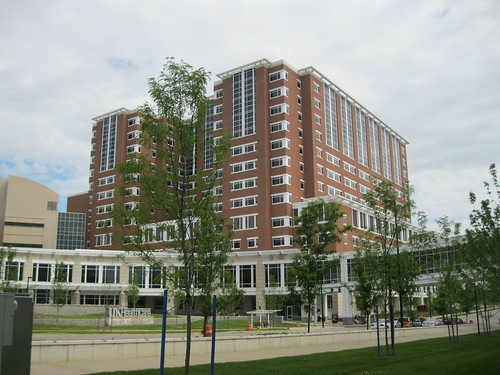 |
| Pavilion A of the Chandler Medical Center – Lexington, Ky. |
If you’ve driven down South Limestone/Nicholasville Rd in the past couple years, you know of this towering medical facility on the south side of UK’s campus. The growing UK Healthcare has constructed a twelve story structure consisting of a four-story pedestal under two eight-story towers. Though not fully opened, a number of units have moved from the old Chandler Medical Center to this new facility.
The new Pavilion features a number of artistic qualities that allow a large, industrial space to seem warm and comforting. It truly is a beautiful facility. A favorite feature of mine is the “Celebrate Kentucky” wall which features digital photographs from across the Commonwealth alongside words from Jesse Stuart‘s poem, Kentucky is My Land.
Since I am Kentucky, and Kentucky is a part of me.
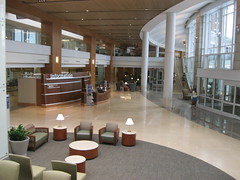
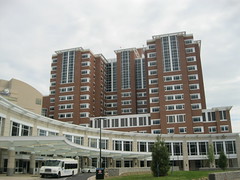
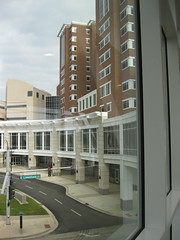
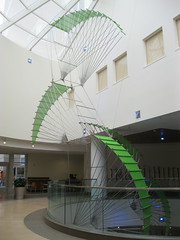
more photos of the Chandler Medical Center are on flickr
 |
| Kentucky Air National Guard C-130 – Georgetown, Ky. |
The history of Georgetown’s community airport began in 1987 when the airport board had only $500 dollars. Seven years later, a 4,000 foot runway opened with a single hangar and no income. When last year’s World Equestrian Games was on the horizon, the Georgetown-Scott County Regional Airport underwent a $4 million renovation which involved the construction of a beautiful terminal, expanded hanger options and a longer runway.
 |
| Terminal at Georgetown-Scott Co. Regional Airport – Georgetown, Ky. |
Not long ago, the airport board broad even more attention to this community airport with a well-executed airshow called AirFest which both I and the lil’ Kaintuckeean attended.
Although his favorite plane was a two-seat experimental that looked quite similar to Anakin’s craft on Star Wars, we both were also quite impressed with the C-130 Hercules transport brought in by the Kentucky Air National Guard. This behemoth plane is impressive.
Although only there for a little over an hour, we witnessed several takeoffs and landings of experimental, military and historic aircraft.
The Georgetown-Scott County Regional Airport is a great facility located just east of Georgetown on US 460. I hope to return next year for another AirFest (if it becomes an annual event)! You can view more pictures of the Airport (and from Airfest) on flickr.
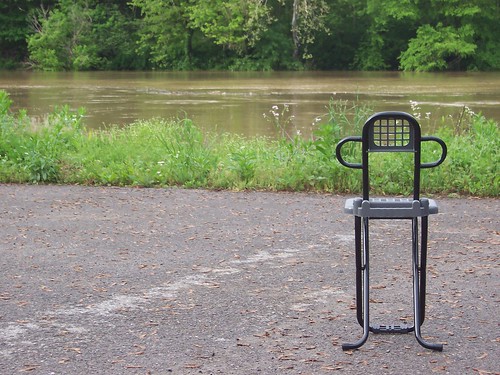 |
| Landing at Oregon, Kentucky |
When you think of Oregon, you probably conjure up an image of a western state with beautiful panoramas of the Pacific Ocean and the towering Cascade Mountains through which the Columbia River cut its own gorge.
Well, I’ve got a different image that I recognize on hearing the word. A winding, descending country road headed toward the river with animals – wild turkey among them – not afraid to explore this road less travelled. At its end, a river as quiet as the boat landing it passes. It is here I pause to savor the silence, the quiet, the peace.
The place: Oregon, Kentucky, a small community on the Kentucky River about five miles from Harrodsburg. It is unknown how the community, originally named Harrods Landing after James Harrod who settled the nearby county seat in 1784, received its current name. What is known is that it assumed its present name by the mid-1800s and it was an important Kentucky River port. Over the years, the community has also been known as Warwick. A roadside historic marker (#1751) reads:
Warwick flourished for some 50 years and was succeeded by Oregon. Both were early shipping ports. Flatboats, during Warwick era, and later steamboats, at Oregon, ran regularly between here and New Orleans. This point was at head of slackwater navigation on Kentucky River. The creek is still called Landing Run because of significance to James Harrod.
Among Oregon’s most notable residents was Clay Lancaster, an authority on American and Kentucky architecture and a leading proponent of historic preservation. He acquired in 1973 the Moses Jones House, an early federal residence in the area, and called it his home until his death. The property is now maintained by the Warwick Foundation.
My connection to Oregon dates to May 6, 2009. Having just completed my final exam in law school, I set out to clear my mind. So I began driving and a saw a few wonderful sites in our beautiful Commonwealth, among them this winding road toward the Kentucky River that took me to Oregon. I sat in my chair, pictured above, and experienced a calmness. Yes, law school was over. And it was here that I found the basis for #NoDestination and this blog.
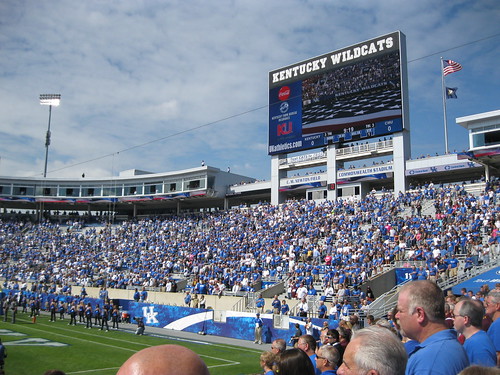 |
| An Upgraded Commonwealth Stadium – Lexington, Ky. |
Yes, it is a difficult time to be a Kentucky football fan. This is not an opportunity for Louisville fans to gloat, either, as both teams sit at 2-4. A recent Herald-Leader article points to Kentucky’s statewide battle against New Mexico’s FBS teams for the worst statewide college football landscape. What an honor.
But at least UK fans can enjoy a few facility upgrades in the technology department over at Commonwealth Stadium. And with the team’s lack of on-the-field success, tickets should be very easy to come by.
New video boards at either end of the stadium are 37′ x 80′ apiece, each ranking 15th nationally for largest video boards. The Daktronics HD boards show a crisp image image during the game that is much improved from the old video boards which were smaller and surrounded by advertising. Today’s larger boards include on-screen advertising and on-screen scores and stats. Everyone loves the new video boards, even if a replay of an up-the-middle run or a Tydlacka-punt doesn’t necessarily make for the most exciting game.
More controversial than Joker’s play-calling has been the ribbon boards which surround the stadium immediately below the upper deck. Although I miss the Ring of Honor that saluted former UK standout players, I understand the need to upgrade facilities. And I’m pleased that those players are now honored with flags bearing their names. Even so, it is hard to read those flags and I hope that UK does something more to connect UK football’s present to its past.
Another issue I have with the video boards is that they are used almost solely for advertising. Scores and stats of the current game appear on both sides of the 50-yard-line and KCTCS, McDonalds, and information about the next women’s volleyball game appear elsewhere. Now I understand the need for advertising revenues, but I was very excited about these ribbon boards because I had hoped we would see regular, live updates from around the conference and around the nation. But alas, these updates are only occasional and are relegated to a small panel at either end zone (the other small end zone ribbon board panels offer play-by-play commentary in closed captioning).
Yes, the upgrades are nice. But they could be better. But we must relish the fact that in terms of total square footage (combining both big-boards and the ribbons), Commonwealth Stadium ranks #3 in the country! That may end up being UK’s standout statistic of the season.
Win or lose, come out and support the Cats! This is homecoming weekend and we face FCS’ Jacksonville State. Help the ‘Cats “bring home the victory!”
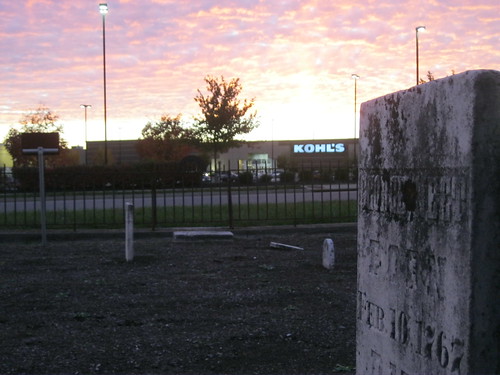 |
| Aaron Farra Family Graveyard – Nicholasville, Ky. |
As Kentucky’s landscape changes, old farmhouses and barns are often torn down. The same goes for churches, post offices and general stores. Entire communities are consumed by an ever-growing suburbia. But what of the cemeteries?
Aaron Farra and his wife, Sally Neet Farra, once owned this land. Aaron and Sally passed this world in 1859 and 1861, respectively, an 1861 map of property owners in Jessamine County identifies a large area of land – on both sides of the Nicholasville Turnpike as it was once called – controlled by different members of the Farra family. Yet, it seems little is known of the family.
Sally’s parents, George Neet (born in Germany in 1767, his headstone is pictured above with the Kohl’s Department Store in the background) and Sally Neet, are buried here. As are a few of Aaron and Sally’s grandchildren. The earliest burial in this family graveyard was in 1826 and the most recent in 1866.
The graveyard is surrounded by an iron fence which was also transplanted from the original site. It is a well-maintained, small cemetery in what many now find an ‘odd’ location. But remember, they were here first!




more photos are available on flickr
Sources: 1861 map; JHS Cemetery Listing; JHS Newsletter; Rootsweb
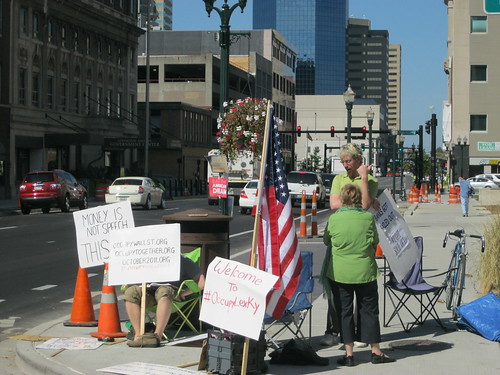 |
| A Small Crowd of #OccupyLexKY Protestors – Lexington, Ky. |
One one end of the block that is home to Lexington’s main Chase Bank branch is a replica statue of the Flying Horse of Gansu. A gift from the Chinese government to the people of Lexington, the original statue dates to the Han dynasty some 200 years BCE. The donor, China, is not well-known for allowing public speech (see, inter alia, Tienanmen Square). But we aren’t in China.
The group includes some unemployed persons, as well as veterans, nurses, students, and others who make up the 99% (a term which contrasts with the overused “wealthiest one percent”). Our #OccupyLexKy demonstrators range in number at any given time from 2 to 20+. The Lexington group began twelve days after similar demonstrations began in New York City (#OccupyWallStreet).
Other similarly-minded occupations have sprung up around the country and around the world. In Kentucky, occupiers have set camp in Lexington, Louisville, Berea, Ashland, Bowling Green, Owensboro and probably other towns as well.
For more information, check out OccupyLexKy.org or their presence on Facebook.
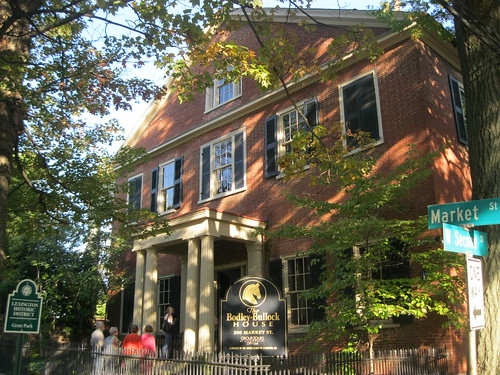 |
| Bodley-Bullock House – Lexington, Ky. |
Built for Mayor Pindell, the house at 200 North Market Street was sold yet inhabited to Col. Thomas Bodley. Bodley came to Lexington a hero of the War of 1812, was clerk of the court when he admitted Henry Clay to the practice of law, and greeted Gen. LaFayette on the Marquis’ 1825 arrival to Lexington, but Bodley would lose this three-story Federal style townhouse to his mortgagee, the Bank of the United States, during the financial Panic of 1819.
The Federal townhouse took a Greek Revival appearance later in the 19th century as other owners added a Doric entrance porch and two-story portico to the northern side of the house which faces the garden.
During the Civil War, the house was occupied at different times by both Union and Confederate troops.
In 1912, the house was purchased for $11,000 by Dr.Waller O. Bullock and his wife, Minnie. Dr. Bullock was the co-founder of the Lexington Clinic which remains one of Lexington’s top healthcare providers, but it is “Miss Minnie” whose story continues to be a part of the home’s history. (She also played a great role in Lexington’s civic and cultural history.)
Miss Minnie passed in 1970 leaving the home in trust to Transylvania University and the property has been maintained since by the Junior League of Lexington. But Miss Minnie remains in the house.
The house, frequently rented for weddings and other events, has a magnificent staircase used for bridal photographs. A few negatives have appeared with the bride … and another woman and child. The child often would come over from the park and talk to Miss Minnie, and it appears she still does.
At another wedding, the guests lingered a bit too long for Miss Minnie’s tastes and so the lights in the foyer turned on and off. As the story goes, the chandelier did not just dim but fully turned on and off… four times. Yes, Miss Minnie continues to show her preferences even after death.
But her greatest preference was her lifestyle as a teetotaler. She allowed no alcohol in the house during her life, and she prohibited it in her will after her death. So how is it that the venue is among Lexington’s most popular for weddings? The trustees overseeing the house changed her will to allow for visitors to consume alcohol. The decision was made in a boardroom on the second floor of the house. The morning after the decision was made, a large crack was found in the glass covering the boardroom table with no evidence of any cause. Yes, Miss Minnie was not pleased.
Certainly, wedding guests have been pleased with the changed. And so too is King Solomon, the town drunk who was the hero of the 1833 cholera plague. A painting of his likeness, purchased by Dr. Bullock, still hangs in the home’s gallery.
Miss Minnie never liked the painting, either.






more pictures of the Bodley-Bullock House on flickr
Sources: BizLex; Dunn’s Old Houses of Lexington; NRHP (Gratz Park); Southern Spirit Guide; Stories from the Haunted South; VisitLex
After they launched, I profiled Kentucky for Kentucky – mainly because their logo is awesome. (It says that we’ve been “A Kickass Commonwealth Since 1792.” Well, it turns out the guys at KY4KY endeavor to promote Kentucky in more ways than their Facebook page.
It is a long shot, but the guys at KY4KY are trying to raise $3.5 million in pledges to create a 30 second spot that would air during the 2012 Super Bowl. I could write it, but they’ve put together a video to give you an idea of what’s up:
Did you watch that? A great marketing idea from a couple of great Kaintuckeeans!
So do your part! And hurry! They’ve only got about 3 weeks left until their self imposed deadline. And if you pledge but the group doesn’t raise the requisite $3.5million, then you don’t pay a dime! Win/Win!
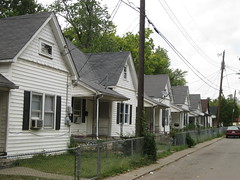 |
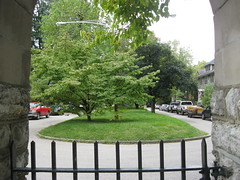 |
|
| Ross Avenue – Lexington, Ky. | Hampton Court – Lexington, Ky. |
Upon my first study of Northside, I learned that the expansive neighborhood is a tale of two cities. Large and opulent homes occupied the high ground while smaller, inexpensive homes filled in the lower elevations between. I wrote:
It has been noted that both the black urban clusters and the predominately white suburbs were both developed off of the major roadways, yet the former occupied the valleys between the more-elevated suburb.
And I noticed this division on a recent walk. Consider Hampton Court and Ross Avenue. These two parallel streets between Third and Fourth Streets appear as a Dickensian Tale of Two Cities.
Hampton Court, a hundred-year-old urban cul-de-sac surrounded by stone walls and arched entries. Built on the site of the old orphan asylum, the beautiful homes and luxury apartments of Hampton Court enjoy a central park-like area in the heart of downtown.
Contrast this with Ross Avenue which was built around the same time as Hampton Court. On its east side are the rear entrances to the Hampton Court homes which today means tall privacy fences and the occasional driveway. On the west are, as pictured, nearly identical one story T-plan houses. When built, this street would have been home to lower-middle-class professionals but today those residents have moved on to suburbia.
In the 1980s, Hampton Court residents, citing an increase in burglaries and vandalism, first padlocked and then welded shut an iron gate (pictured) that opened their court to pedestrians from Fourth Street. These two streets grew further apart.
But despite their differences, these two streets and their residents have lived and continue to live in facultative symbiosis. These two streets operate as a lesson and reminder of urban planning. A lesson which slaps an even more segregated suburbia in the face. A lesson that shows design excellence by providing affordable housing in a the urban setting with quality of construction. Quality exists on both Hampton and Court; if it did not these homes would not have survived one hundred years.







more photos of Northside on flickr